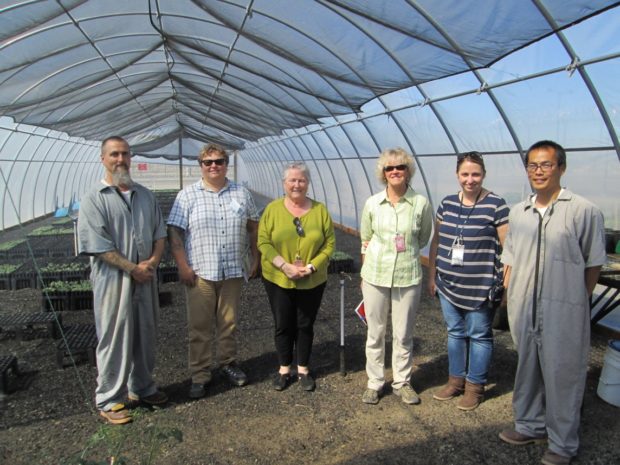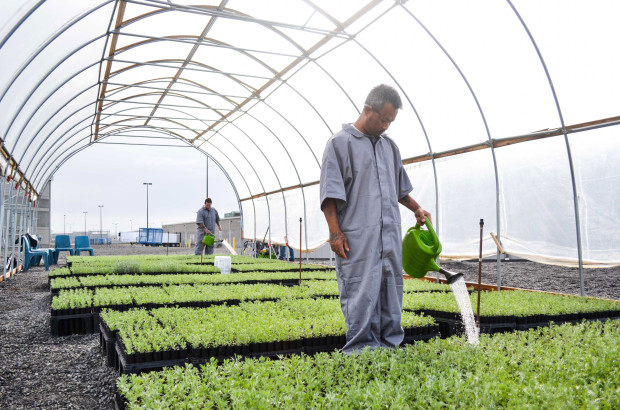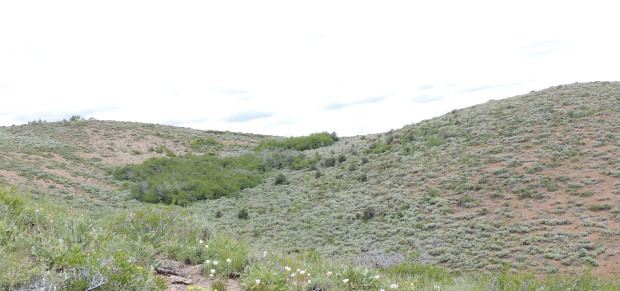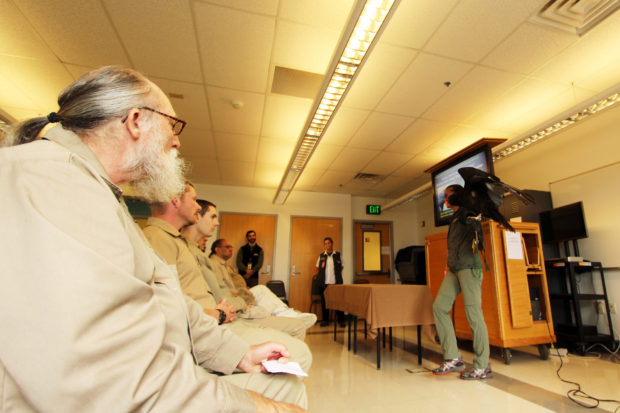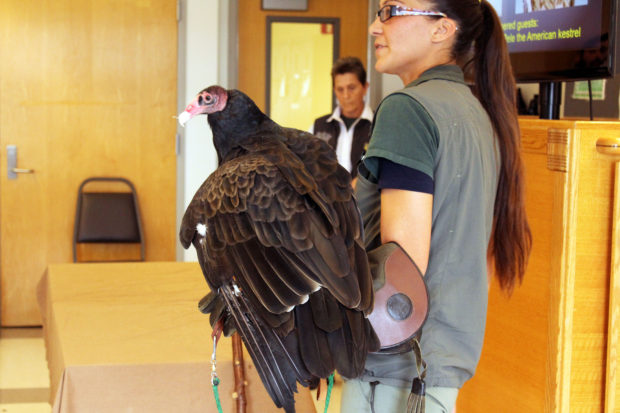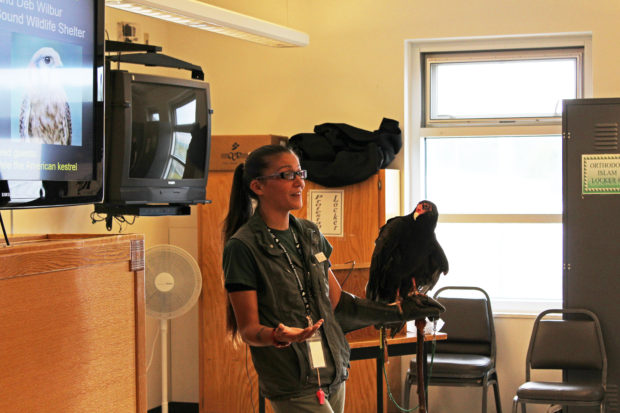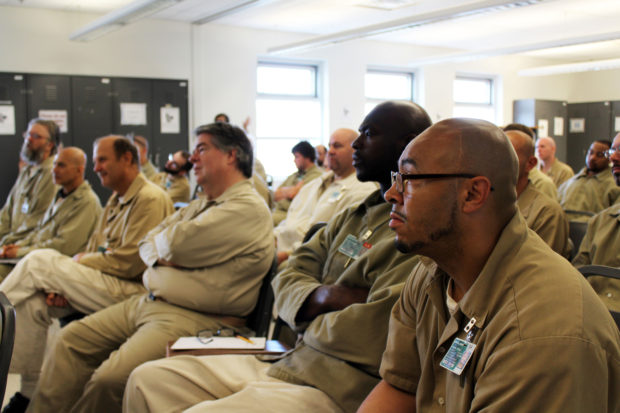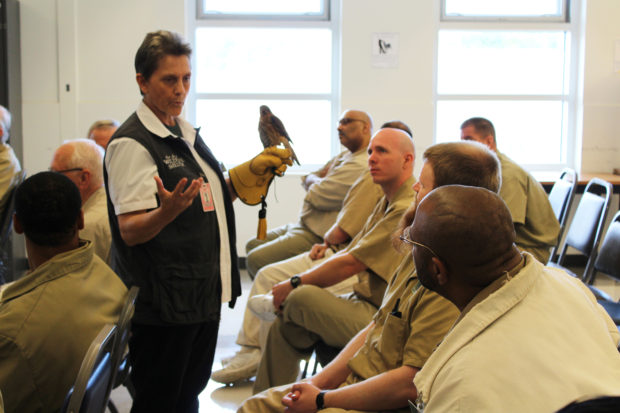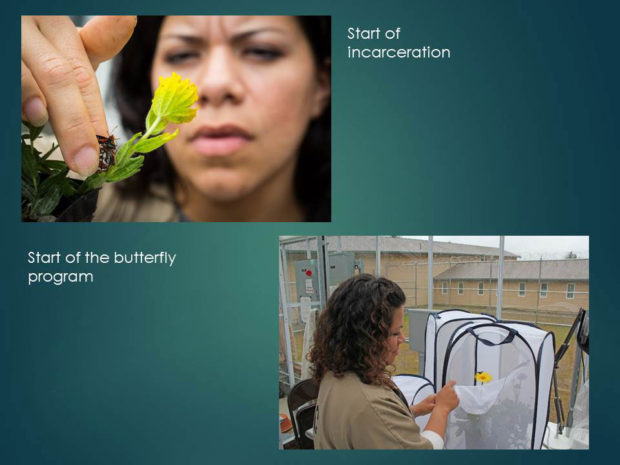by Grady Mitchell, Roots of Success Instructor and Master Trainer, Stafford Creek Corrections Center.

Grady Mitchell speaks to a graduating class. He has taught the Roots of Success curriculum twelve times, and was certified as a Master Instructor in 2015.
A few years ago, prior to Roots of Success (ROS) someone could have held a conversation on sustainability and I’m sure it would have been as interesting to me as popcorn without the salt. Today I am not only able to present the curriculum to students, but also have a variety of discussions with them on the subject. In a sense my own experience has given me even more material to share with students (myself and my colleagues like to refer to our classes as peer to peer education) because most of them had no idea the impact of their habits and choices have on the environment, any more than I.
Sustainability in simple terms means being able to meet our needs now without compromising the ability of future generations to meet theirs. However, this term has been taken hostage so to speak because manufacturers use it for their own selfish gain. We as consumers have to take sustainability back and know that sustainability is survivability. By adding the word ‘Just’ before Sustainability, makes it fair and equal.
This is significant to me because in order for the future generations to be sustained, an interest on the matter needs to prevail now. Failure can’t be an option because to do so could literally mean the extinction of those we love dearly and plan on leaving our legacy to. Sustainability is a built in feature of all natural environmental systems provided that human interference is absent or minimized.

Grady Mitchell sits with his fellow instructors a graduating class of Roots of Success. Photo by DOC staff.
To get to a more sustainable lifestyle is going to require, inevitably, some radical changes in attitudes, values and behavior. The answer to creating global values and actions is blurred for now. How we get to less pollutants and more sustainable reliances and reuse may depend on generations yet to come (if we make it that far), because as it stands, we haven’t been doing too good of a job. Changing our personal habits; reducing the carbon footprint; our practices being altered for the benefit of sustainability is ‘just.’ In the book “Last Child in the Woods,” a phrase was coined called Nature Deficit Disorder. All it takes to cure this disorder is to get outside and enjoy nature. With seven billion people in the world, imagine the impact from just being sustainable or creating nature. Imagine a society where our lives are as immersed in nature as they are technology.

Turtle technicians x and x hold healthy western pond turtles prior to releasing them. The turtle program staff sponsor, Shaun Piliponis, stands with them. Photo by Sadie Gilliom.
In order to make sustainability more inclusive takes education and a willingness to embrace lifestyle changes. The guerrilla gardener of South Central Los Angeles, Ron Finley stated, “If kids grow kale, kids eat kale.” If the inspiration was focused on making sustainability hip, cool, the thing to do, then we have a cure for Nature Deficit Disorder. Allowing our generation to see with their own eyes and then pass it on to the next is “just.” César Chavez stated:
“Once social change begins, it cannot be reversed. You cannot uneducate the person who has learned to read. You cannot humiliate the person who feels pride. You cannot oppress the people who are not afraid anymore. We have seen the future, and the future is ours.”
One of the videos available to our students in our Roots of Success class tells us, in 1915 a Canadian commission on conservation made an interesting proclamation, they said “each generation is entitled to the Interest on the Natural Capital, but the Principal should be handed on unimpaired.” We enjoy the fruit (the interest) from the tree (the principal), but if we cut the trees down both the principal and the interest will be gone forever. So in the end, Just Sustainability could really mean we all take responsibility not only for ourselves, but for community, the planet and most important, the ones who come after us.










 The prison has also set the standard for sorting waste. Without any fancy equipment, they have figured out how to turn the waste stream into valuable commodities. They sort their waste at the source, or “up stream.” Every day, porters (we call them waste stream technicians) sort the waste stream into dedicated cans, and the results are impressive. Nearly everything is reclaimed or recycled; all that’s left is a tiny can of mixed-materials (see photo).
The prison has also set the standard for sorting waste. Without any fancy equipment, they have figured out how to turn the waste stream into valuable commodities. They sort their waste at the source, or “up stream.” Every day, porters (we call them waste stream technicians) sort the waste stream into dedicated cans, and the results are impressive. Nearly everything is reclaimed or recycled; all that’s left is a tiny can of mixed-materials (see photo).


